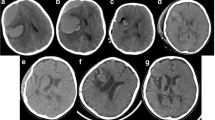Summary
The modern treatment, with concentrates of the deficient factors, of undue bleeding due to haemophilia is briefly discussed.
Seven cases are described of haemophiliacs (including three with Christmas disease or factor IX deficiency) who developed serious complications following head injury. Six were young children. One case of extradural haematoma, two of subdural, one of intracerebral and one of a very large subaponeurotic haematoma of the scalp were operated on, and there was only one death (a case of subdural haemorrhage). Two other patients recovered without operation. All received treatment with concentrates of the deficient factor with the object of restoring normal blood coagulability, especially during and following surgical operation.
Close collaboration with a specialized haematological department is necessary for this type of surgery. Appropriate therapy (fresh-frozen plasma, if concentrates are not available) should be started as soon as possible after injury. Angiography and operation should be avoided unless absolutely necessary and then, only the minimum operation performed which is likely to save life.
Zusammenfassung
Die moderne Behandlung mit Konzentraten der fehlenden Blutgerinnungsfaktoren wird kurz besprochen. Dann werden 7 Fälle von Blutern beschrieben, bei denen sich nach Schädeltraumen schwere Komplikationen entwickelten. Sechsmal handelte es sich um junge Kinder. Ein Fall mit epiduralem, 2 mit subduralem, einer mit einem intrazerebralen und einer mit einem sehr großen Kopfschwartenhämatom wurden operiert. Davon starb nur einer der Fälle mit einem subduralen Hämatom. Zwei andere Patienten erholten sich ohne Operation. Alle wurden mit Konzentraten der fehlenden Blutgerinnungsfaktoren behandelt mit dem Ziel, die normale Gerinnungsfähigkeit wieder herzustellen, besonders während und nach dem chirurgischen Eingriff.
Enge Zusammenarbeit mit einer spezialisierten hämatologischen Abteilung ist die Voraussetzung für diese Art von Chirurgie. Die entsprechende Behandlung sollte so früh wie möglich nach dem Trauma begonnen werden, notfalls, wenn Konzentrate der Gerinnungsfaktoren nicht zur Verfügungstehen, mit frisch gefrorenem Trockenplasma. Angiographie und Operation sollten nur dann ausgeführt werden, wenn sie absolut unerläßlich sind, und auch dann sollte die kleinste Art des Eingriffes gewählt werden, die geeignet ist, das Leben zu retten.
Résumé
Le traitement moderne de l'hémorragie excessive dûe à l'hémophilie par des concentrations de facteurs déficitaires est brièvement discutée.
L'auteur rapporte sept cas d'hémophiles (dont 3 cas de maladie de Christmas ou de carence du facteur IX) qui ont présenté des complications graves à la suite d'un traumatisme cranien. Six de ces malades sont de jeunes enfants. Un cas d'hématome extra-dural, 2 cas d'hématome intra-cérébral et un cas de gros hématome sous-aponévrotique du scalpe ont été opérés; il y a eu seulement un décés (un cas d'hématome sous-dural). Les deux autres malades sont rétablis sans opération. Tous les malades ont reçu le traitement par des concentrations de facteurs déficitaires visant à rétablir la coagulabilité normale, surtout en pré et post opératoire.
La collaboration étroite avec le département d'hématologie est nécessaire dans ce genre de chirurgie. Le traitement approprié (plasma frais congelé, si les concentrations ne sont pas valables) doit être administré le plutôt possible après le traumatisme. L'angiographie, l'intervention doivent être évitées, en dehors d'une nécessité absolue et dans ce cas seule l'intervention à minima a la chance de sauver le malade.
Riassunto
L'Autore discute brevemente il trattamento moderno dell'emofilia che si basa sulla sostituzione dei fattori deficitari per la coagulazione del sangue.
Egli descrive sette casi di emofilici (comprendendo anche un caso di m. di Christmas ed un caso di deficienza del fattore IX), che hanno mostrato gravi complicazioni dopo un trauma cranico. Sono stati operati un ematoma extradurale, due subdurali ed uno sottoaponeurotico del vertice. Si è avuto solamente un decesso (un ematoma subdurale). Due altri pazienti sono guariti senza operazione. Tutti hanno avuto un trattamento con concentrati dei fattori deficienti, con il proposito di restaurare la normale coagulabilità sanguigna, particolarmente durante e dopo l'operazione chirurgica.
Per questo tipo di chirurgia è necessaria la collaborazione con un laboratorio ematologico specializzato. Una terapia idonea (plasma liofilizzato) deve essere iniziata subito dopo il trauma. L'angiografia e l'intervento chirurgico devono essere evitati se non strettamente indispensabili ed in ogni caso deve essere compiuta l'operazione meno grave possibile.
Resumen
Se discute brevemente el tratamiento moderno de las hemorragias masivas debidas a hemofilia por acumulo de factores deficitarios.
El autor cita siete casos de hemofilia (de ellos 3 casos de enfermedad de Christmas o de carencia del factor IX) que presentaron complicaciones graves después de un traumatismo de craneo. Seis de estos enfermos eran niños de corta edad. Un caso de hematoma extradural, 2 casos de hematomas intracerebrales y 1 caso de un gran hematoma subaponeurótico del scalp fueron operados. Todos los enfermos recibieron un tratamiento en forma de concentración de los factores deficitarios tendiendo a restablecer una coagulabilidad normal, sobre todo pre y post-operatoria.
En este tipo de cirugía es necesaria una estrecha colaboración con el departamento de hematología. Un tratamiento adecuado (plasma fresco congelado, si las concentraciones no son buenas) sebe ser administrado lo antes posible después del traumatismo. Deben evitarse en lo posible la angiografía y la intervención quirúrgica, recurriendose a esta en casos de extrema necesidad y recurriendo a una intervención mínima para salvar la vida del enfermo.
Similar content being viewed by others
References
Gleave, J. R. W., Personal communication.
Kerr, C. B., Intracranial haemorrhage in haemophilia. J. Neurol. Neurosurg. Psychiat.27 (1964), 166–173.
Macfarlane, R. G., et al., Surgery in Haemophilia. Lancet2 (1957), 251–259.
Silverstein, A., Intracranial Bleeding in Hemophilia. Arch. Neurol. (Chicago)3 (1960), 141–157.
Simpson, D. A., andH. N. Robson, Intracranial Haemorrhage in Disorders of Blood Coagulation. Aust. N. Z. J. Surg.29 (1960), 287–303.
Author information
Authors and Affiliations
Rights and permissions
About this article
Cite this article
Potter, J.M. Head injury and haemophilia. Acta neurochir 13, 380–387 (1965). https://doi.org/10.1007/BF02074420
Issue Date:
DOI: https://doi.org/10.1007/BF02074420



